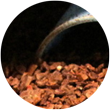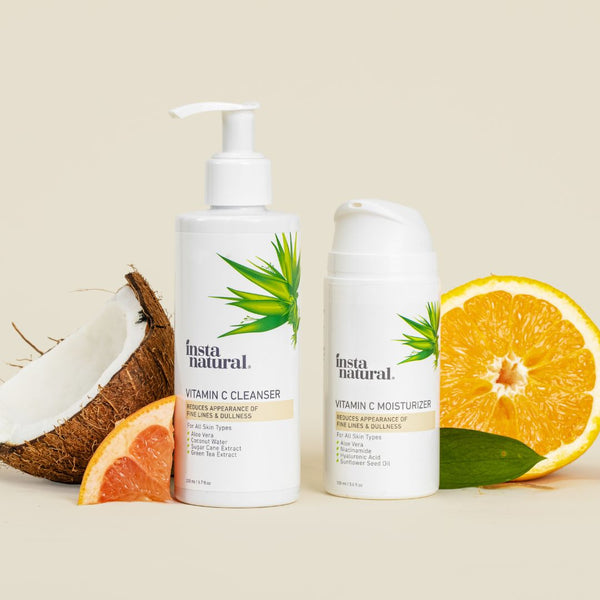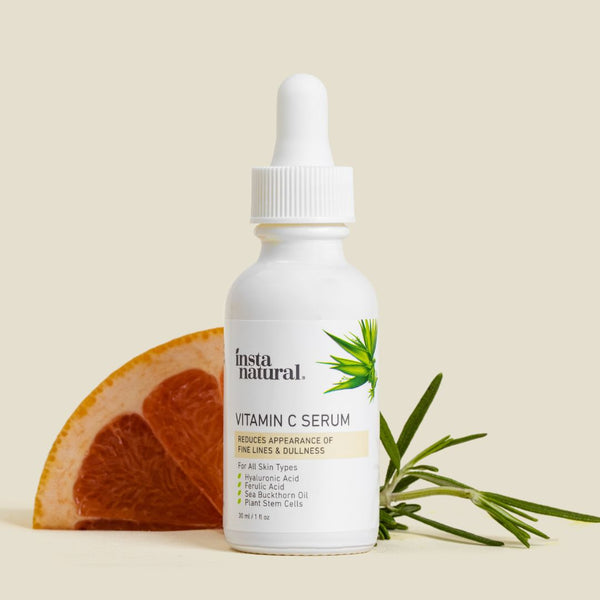
Let's Talk Cellulite and Stretch Marks
It's probably safe to say that we've all experienced cellulite, stretch marks, or both at some time in our lives. You get an idea of just how universal these issues are when even beauties like Kim Kardashian have said, "I have cellulite, just like almost every other woman on the planet."
When everything from genetics to puberty can cause dimples and marks, their prevalence isn't surprising. Fortunately, cellulite and stretch marks are pretty benign problems — they're purely cosmetic flaws, and readily treatable at that. Here are some effective, natural ways you can diminish stretch marks and cellulite.
What Is Cellulite?
Despite its clinical-sounding name, cellulite is just ordinary fat that hangs out right beneath the surface of your skin. When this fat accumulates, it pushes against fibrous connective tissue under the skin. This phenomenon is what creates cellulite's signature dimply, "orange peel" look.
Cellulite's favorite places include your hips, thighs, and abdomen. Researchers call cellulite a "physiologic" condition rather than a "pathologic" one. That's a fancy way of saying that cellulite may be a bathing-suit saboteur, but it's otherwise completely harmless.
What Causes Cellulite?
A common misperception is that if you have cellulite, you must be overweight. In reality, the causes of cellulite are complex and manifold. While having a few extra pounds on your frame may contribute to cellulite, people who have it are not necessarily overweight and are far from alone. In fact, a 2014 Polish study found that cellulite is a problem for a whopping 85 to 98% of women. Looks like Kim Kardashian was spot-on with her statement.
So what does cause cellulite? Here's a list of the top culprits:
- Certain types of connective tissue You may have noticed that men don't struggle with cellulite quite as often as women. The reason for this could be that women are more likely to have some types of connective tissue associated with cellulite.
- Genetics If your mother, grandmothers, aunts, etc. have cellulite, you're likely to have it as well. For cellulite to develop, you have to have certain genes. These genes determine several characteristics related to cellulite, such as race, subcutaneous fat distribution (how the fat underneath your skin arranges itself), metabolism, and circulation problems. So while you can thank your mom for her chocolate chip cookie recipe and gorgeous eyes, you can also probably thank her for your dimples — both kinds.
- Diet A diet low in fiber and high in carbohydrates, fat, and salt can predispose you to developing cellulite.
- Hormones Most women develop cellulite at or after puberty, and hormones are likely to blame. Estrogen, prolactin, insulin, and thyroid hormones are all necessary for cellulite production.
- Lifestyle If you are sedentary, smoke, or tend to stand or sit in one position for long periods of time, you're more likely to develop cellulite.
What Are Stretch Marks?
Anyone who has ever had a baby, experienced a change in weight, or even gone through puberty has seen a stretch mark or two. Stretch marks — or what your doctor will call "striae" — like to form on the stomach, thighs, hips, lower back, breasts, and upper arms. At first, the marks often look red or purple and might be slightly indented. Over time, they tend to fade into shiny silver or white marks. Fresh stretch marks might itch or hurt, but that doesn't last forever. Just like cellulite, stretch marks are not harmful and are purely a cosmetic concern.
What Causes Stretch Marks?
As you might guess, stretch marks get their name from their physical cause — the stretching of the skin. We'll briefly touch on the formation process. The layer of your skin that you can see is the epidermis, or top layer. Just underneath that is the dermis, or middle layer, which allows skin to hold its shape. When the dermis is repeatedly stretched, it starts to lose its elasticity and tear. Those little tears cause scars to form on the epidermis.
Here are a few of the things that can cause excessive stretching of the skin:

- Pregnancy Some of the hormones associated with pregnancy along with the natural weight gain may contribute to stretch marks.
- Weight gain If you've ever gained a significant amount of weight, you've probably added a few stretch marks. Sometimes weight-related stretch marks can be hard to see, though, until you've lost the weight.
- Medications Some steroid creams and medications may contribute to stretch marks.
- Diseases Certain diseases, such as Cushing's, may cause stretch marks.
Diminishing the Appearance of Cellulite
If you have cellulite that you'd like to make less noticeable, you have a lot of options. While you may not be able to get rid of it completely, there are many products and treatments you can try, along with lifestyle changes, to diminish its appearance. As far as lifestyle changes go, make sure you're drinking enough water, exercising, and eating right. Staying active and hydrated generally helps your skin look and feel its best. Here are some other effective remedies to try.
Cellulite Creams
The thing to remember with creams is that they are only as good as their ingredients. With the right ingredients, cellulite creams work in two ways; they shrink the fat cells that protrude against tissue, causing lumps and bumps, and they restore the structure of surface skin cells for the smoothest appearance possible. Read what is in a cream before you buy it, watching for the following ingredients:
- Caffeine It's not just for mornings anymore! Caffeine is effective against cellulite because it increases circulation, thereby shrinking fat cells. You should see an immediate difference as well as lasting smoother skin in about 30 days.
- Retinol According to dermatologist Francesca Fusco at Mount Sinai School of Medicine, caffeine is most effective as a cellulite treatment when combined with retinol. Retinol increases the amount of collagen in your skin, helping repair your skin's structure in the long run. The result is a much smoother topography.
- REGU-SLIM This proprietary blend of cellulite-fighting ingredients packs a wallop. REGU-SLIM contains several ingredients, including paullinia cupana seed extract and caffeine, that promote lipolysis, or the destruction of fat. This patented blend also smooths out the skin's surface.
- Nutrients Healthy skin is beautiful skin, so also look for a cream with nutrients like vitamin E to keep your skin nourished, soft, and radiant.
Dry Brushing and Massage
With dry brushing, you take a dry body brush and scrub your thighs, buttocks, and other problem areas vigorously once or twice per day. Similarly, massages aimed to reduce cellulite, typically called "lipomassage," kneads the skin with the rollers of a hand-held machine.
Both of these treatments have benefits and limitations. We'll start with limitations — neither will get rid of your cellulite, per se. On the bright side, they can temporarily reduce the appearance of cellulite. Superficial, vigorous skin stimulation boosts circulation to your skin's surface, causing it to plump and swell. That swelling masks the dimpling that cellulite causes on the epidermis.
You may also hear claims that vigorous massage diminishes cellulite by reducing excess fluid. The reduction of fluid makes cellulite less noticeable by lowering the pressure on the skin caused by bloating. Lower pressure, in turn, may mean fewer dimples on the connective tissue.
DIY Cellulite Coffee Scrub
We know that rubbing coffee on your skin to get rid of cellulite may seem a little far-fetched at first. But, believe it or not, it actually works, at least for a week or so. Yale dermatologist Dr. Mona Gohara points out that coffee grounds contain caffeine, which, as we mentioned before, "stimulates dilation while the scrubbing motion increases circulation, plumping up the skin and making cellulite look less obvious." Additionally, coffee grounds are loaded with antioxidants, which can boost the production of collagen.
To make your own cellulite coffee scrub, you'll need the following:
- 1 cup coffee grounds
- 6 tablespoons coconut oil
- 3 tablespoons sea salt or sugar
- Empty jar
- Dry body brush
Mix the dry ingredients together, then microwave the coconut oil if solid (10-15 seconds at a time, careful to not get hot!). Add the oil to the dry ingredients and mix well. Transfer the ingredients to a jar that is water-tight. Before you get in the shower, lightly dry brush your problem areas in a circular pattern. In the shower, scrub the coffee mixture onto your cellulite areas in a circular pattern. Rinse and repeat each time you shower for better results.
Diminishing the Appearance of Stretch Marks
Stretch marks are a form of scar, so you'll have the most success treating them when they're fresh. The stretch marks that respond best to natural treatments are the new, reddish or purple kind. Once stretch marks turn gray or white, they are mature and more resistant to treatment. At that point, however, you can still lessen their appearance considerably with diligent treatment. Here are a few options that might work for you.
Creams
Like cellulite creams, ingredients make or break a stretch mark cream. When shopping for a cream, look for the following ingredients:

- REGU-STRETCH This is a proprietary blend of ingredients (panthenol, marrubium vulgare extract, and palmitoyl tripeptide-5, in case you were wondering) specifically formulated for stretch mark treatment. These ingredients help support the structure of the dermis — that over-stretched middle layer of the skin — in addition to fading the superficial appearance of stretch marks.
- Vitamin C An antioxidant, vitamin C as a topical can actually increase collagen production, helping the skin regain the elasticity it loses when continuously stretched. Interestingly, some dermatologists also recommend oral vitamin C supplements to help make stretch marks less obvious.
- Argan Oil Full of antioxidants, argan oil can also boost collagen production and help the skin get back its elasticity. Argan oil is also great for nourishing and smoothing the skin.
- Alpha Arbutin This is a glycoside extracted from the bearberry plant that prevents melanin formation. Melanin is what gives skin and scars their color, so arbutin serves as a skin brightener and may also even skin tone.
- Vitamin E Nourishes and restores the skin by removing free radicals, unstable chemical compounds that harm the structure of cells.
Microdermabrasion
This treatment abrades the skin's surface with tiny crystals, polishing it in the process. A small vacuum then retrieves the crystals from the skin. Microdermabrasion removes the epidermis, the skin's top layer, allowing a new, healthier, and more elastic layer to emerge. This treatment can work for everything from stretch marks to blemishes. Microdermabrasion must be performed by a professional.
Coffee and Salt Scrubs
The same principles that make a coffee scrub work for cellulite can also make it work for stretch marks. Exfoliation can treat a variety of skin problems by removing dead skin cells from the surface and revealing newer, healthier skin. In this way, exfoliation is a less intensive — and less expensive — version of microdermabrasion.
One way to exfoliate is with a coffee scrub. As we explained above, coffee contains caffeine that stimulates blood flow, thereby encouraging cell regeneration. Another option is a salt or sugar scrub. This will exfoliate just as well, minus the caffeine. You can also make these scrubs with olive oil, which will help moisturize your skin. Here's our favorite stretch mark scrub recipe:
- 1 cup olive oil
- 1 cup sugar or salt
- The scent of your choice (a favorite essential oil or citrus peel for a refreshing aroma)
While in the shower, take a generous handful of scrub and apply it to your stretch marks. Wet a hard loofah, and begin rubbing the scrub into your marks gently in small, circular patterns. Rub for a minute or two and rinse. Make sure you do this four to five times per week for the best results.
If there's one thing you should know about cellulite and stretch marks, it's that you're not alone. So much of what causes these cosmetic issues is just part of being human. We all have them, but now you can do something positive about it.



